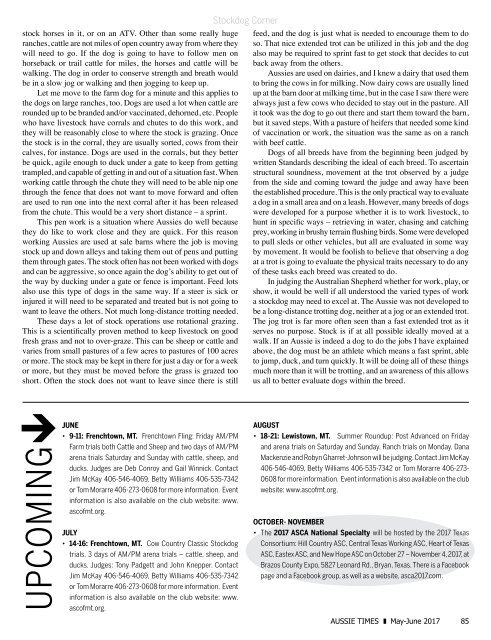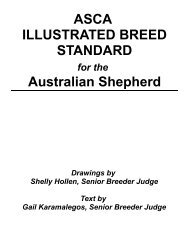You also want an ePaper? Increase the reach of your titles
YUMPU automatically turns print PDFs into web optimized ePapers that Google loves.
stock horses in it, or on an ATV. Other than some really huge<br />
ranches, cattle are not miles of open country away from where they<br />
will need to go. If the dog is going to have to follow men on<br />
horseback or trail cattle for miles, the horses and cattle will be<br />
walking. The dog in order to conserve strength and breath would<br />
be in a slow jog or walking and then jogging to keep up.<br />
Let me move to the farm dog for a minute and this applies to<br />
the dogs on large ranches, too. Dogs are used a lot when cattle are<br />
rounded up to be branded and/or vaccinated, dehorned, etc. People<br />
who have livestock have corrals and chutes to do this work, and<br />
they will be reasonably close to where the stock is grazing. Once<br />
the stock is in the corral, they are usually sorted, cows from their<br />
calves, for instance. Dogs are used in the corrals, but they better<br />
be quick, agile enough to duck under a gate to keep from getting<br />
trampled, and capable of getting in and out of a situation fast. When<br />
working cattle through the chute they will need to be able nip one<br />
through the fence that does not want to move forward and often<br />
are used to run one into the next corral after it has been released<br />
from the chute. This would be a very short distance – a sprint.<br />
This pen work is a situation where Aussies do well because<br />
they do like to work close and they are quick. For this reason<br />
working Aussies are used at sale barns where the job is moving<br />
stock up and down alleys and taking them out of pens and putting<br />
them through gates. The stock often has not been worked with dogs<br />
and can be aggressive, so once again the dog’s ability to get out of<br />
the way by ducking under a gate or fence is important. Feed lots<br />
also use this type of dogs in the same way. If a steer is sick or<br />
injured it will need to be separated and treated but is not going to<br />
want to leave the others. Not much long-distance trotting needed.<br />
These days a lot of stock operations use rotational grazing.<br />
This is a scientifically proven method to keep livestock on good<br />
fresh grass and not to over-graze. This can be sheep or cattle and<br />
varies from small pastures of a few acres to pastures of 100 acres<br />
or more. The stock may be kept in there for just a day or for a week<br />
or more, but they must be moved before the grass is grazed too<br />
short. Often the stock does not want to leave since there is still<br />
Stockdog Corner<br />
feed, and the dog is just what is needed to encourage them to do<br />
so. That nice extended trot can be utilized in this job and the dog<br />
also may be required to sprint fast to get stock that decides to cut<br />
back away from the others.<br />
Aussies are used on dairies, and I knew a dairy that used them<br />
to bring the cows in for milking. Now dairy cows are usually lined<br />
up at the barn door at milking time, but in the case I saw there were<br />
always just a few cows who decided to stay out in the pasture. All<br />
it took was the dog to go out there and start them toward the barn,<br />
but it saved steps. With a pasture of heifers that needed some kind<br />
of vaccination or work, the situation was the same as on a ranch<br />
with beef cattle.<br />
Dogs of all breeds have from the beginning been judged by<br />
written Standards describing the ideal of each breed. To ascertain<br />
structural soundness, movement at the trot observed by a judge<br />
from the side and coming toward the judge and away have been<br />
the established procedure. This is the only practical way to evaluate<br />
a dog in a small area and on a leash. However, many breeds of dogs<br />
were developed for a purpose whether it is to work livestock, to<br />
hunt in specific ways – retrieving in water, chasing and catching<br />
prey, working in brushy terrain flushing birds. Some were developed<br />
to pull sleds or other vehicles, but all are evaluated in some way<br />
by movement. It would be foolish to believe that observing a dog<br />
at a trot is going to evaluate the physical traits necessary to do any<br />
of these tasks each breed was created to do.<br />
In judging the Australian Shepherd whether for work, play, or<br />
show, it would be well if all understood the varied types of work<br />
a stockdog may need to excel at. The Aussie was not developed to<br />
be a long-distance trotting dog, neither at a jog or an extended trot.<br />
The jog trot is far more often seen than a fast extended trot as it<br />
serves no purpose. Stock is if at all possible ideally moved at a<br />
walk. If an Aussie is indeed a dog to do the jobs I have explained<br />
above, the dog must be an athlete which means a fast sprint, able<br />
to jump, duck, and turn quickly. It will be doing all of these things<br />
much more than it will be trotting, and an awareness of this allows<br />
us all to better evaluate dogs within the breed.<br />
UPCOMINGt<br />
JUNE<br />
• 9-11: Frenchtown, MT. Frenchtown Fling: Friday AM/PM<br />
Farm trials both Cattle and Sheep and two days of AM/PM<br />
arena trials Saturday and Sunday with cattle, sheep, and<br />
ducks. Judges are Deb Conroy and Gail Winnick. Contact<br />
Jim McKay 406-546-4069, Betty Williams 406-535-7342<br />
or Tom Morarre 406-273-0608 for more information. Event<br />
information is also available on the club website: www.<br />
ascofmt.org.<br />
JULY<br />
• 14-16: Frenchtown, MT. Cow Country Classic Stockdog<br />
trials. 3 days of AM/PM arena trials – cattle, sheep, and<br />
ducks. Judges: Tony Padgett and John Knepper. Contact<br />
Jim McKay 406-546-4069, Betty Williams 406-535-7342<br />
or Tom Morarre 406-273-0608 for more information. Event<br />
information is also available on the club website: www.<br />
ascofmt.org.<br />
AUGUST<br />
• 18-21: Lewistown, MT. Summer Roundup: Post Advanced on Friday<br />
and arena trials on Saturday and Sunday. Ranch trials on Monday. Dana<br />
Mackenzie and Robyn Gharret-Johnson will be judging. Contact Jim McKay<br />
406-546-4069, Betty Williams 406-535-7342 or Tom Morarre 406-273-<br />
0608 for more information. Event information is also available on the club<br />
website: www.ascofmt.org.<br />
OCTOBER- NOVEMBER<br />
• The <strong>2017</strong> ASCA National Specialty will be hosted by the <strong>2017</strong> Texas<br />
Consortium: Hill Country ASC, Central Texas Working ASC, Heart of Texas<br />
ASC, Eastex ASC, and New Hope ASC on October 27 – November 4, <strong>2017</strong>, at<br />
Brazos County Expo, 5827 Leonard Rd., Bryan, Texas. There is a Facebook<br />
page and a Facebook group, as well as a website, asca<strong>2017</strong>.com.<br />
AUSSIE TIMES May-June <strong>2017</strong> 85



